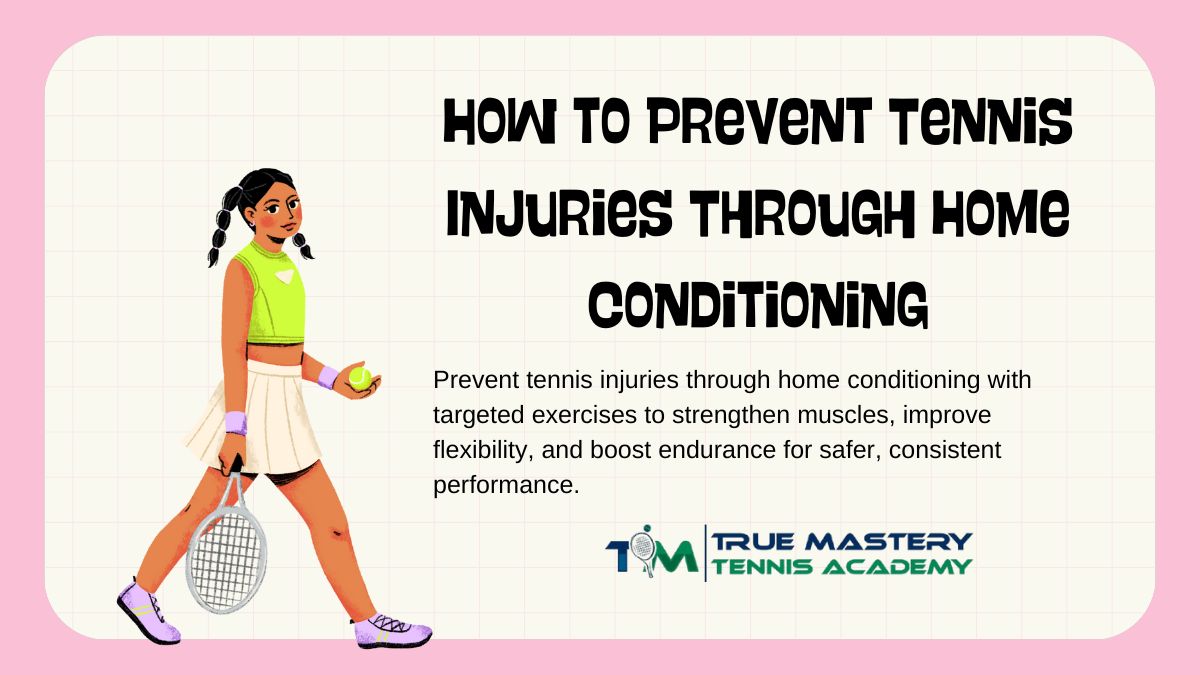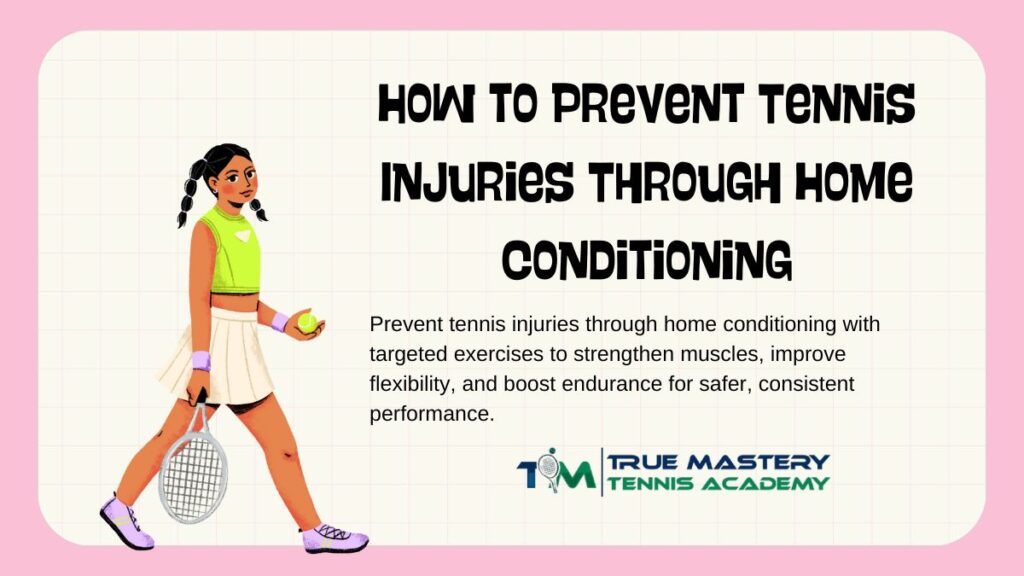How to Prevent Tennis Injuries Through Home Conditioning
Just in any sports like swimming, badminton, basketball or tennis, injuries can disrupt momentum, derail training, and even sideline a player for weeks. The combination of sudden sprints, lateral movements, rotational strokes, and repeated stress on joints makes injury prevention critical. The good news is that many of the risks can be mitigated with a structured home conditioning program. True Master Tennis Academy emphasizes proactive conditioning to ensure players remain fit, strong, and injury-resistant while enhancing their on-court performance.
Understanding Common Tennis Injuries
Tennis players frequently experience injuries such as tennis elbow, shoulder strains, wrist pain, ankle sprains, knee issues, and lower back discomfort. These often result from overuse, poor technique, inadequate warm-up, or insufficient muscular support. While professional players may have access to physiotherapists and specialized gyms, home conditioning allows players to build the foundational strength, stability, and mobility necessary to prevent these injuries before they happen.
The Role of Warm-Ups in Injury Prevention
Every home conditioning session should start with a proper warm-up. Dynamic stretches such as arm circles, leg swings, torso twists, and jogging in place increase blood flow and prepare muscles and joints for the explosive movements in tennis. Mobility exercises targeting the hips, shoulders, knees, and ankles are essential. Regularly performing these exercises at home primes the body for sudden stops, starts, and rotations, reducing the likelihood of sprains, strains, or joint stress.

Strength Training to Support Joints and Muscles
Strengthening key muscle groups is one of the most effective ways to prevent tennis injuries. Bodyweight exercises such as squats, lunges, push-ups, planks, and glute bridges can be performed at home with no equipment. Focusing on the shoulders, forearms, core, and legs ensures the muscles surrounding joints are strong and supportive. For example, strengthening the rotator cuff muscles helps stabilize the shoulder during serves, reducing the risk of impingement or tears. Similarly, improving quadriceps, hamstrings, and calf strength enhances knee and ankle stability for safer lateral movements.
Agility and Footwork for Safer Movement
Quick, precise footwork is essential in tennis, but improper movement patterns can increase injury risk. Practicing footwork drills at home, such as side-to-side shuffles, in-and-out steps, and multi-directional sprints, improves coordination and body control. Using tape, cones, or markers to simulate court movement allows players to rehearse safe landings, quick pivots, and proper weight distribution. True Master Tennis Academy highlights that consistent footwork training reduces the likelihood of sprained ankles and knee injuries by teaching the body to move efficiently.
Core Stability and Balance
A strong core is crucial in distributing force across the body during strokes and preventing undue stress on the lower back and shoulders. Home exercises such as planks, side planks, bird dogs, and stability ball work enhance core endurance and balance. Research indicates that core strengthening improves posture and reduces the risk of overuse injuries in tennis, particularly in the lower back. Players who invest time in core conditioning at home find that strokes feel more controlled, and sudden movements become less stressful on joints.
Flexibility and Recovery
Tennis players require a wide range of motion to execute serves, groundstrokes, and volleys effectively. Incorporating static stretches after workouts and on non-training days enhances flexibility, which reduces the risk of muscle strains. Focus areas include the shoulders, hamstrings, calves, hip flexors, wrists, and lower back. Foam rolling or using massage tools at home supports recovery, alleviates tightness, and improves circulation. True Master Tennis Academy integrates flexibility routines into training plans, ensuring that mobility complements strength and reduces the risk of repetitive strain injuries.
Plyometrics for Injury-Resistant Muscles
Plyometric exercises, when done correctly, not only boost explosive power but also train muscles and tendons to absorb impact efficiently. At-home plyometric routines include jump squats, lateral hops, and box jumps on stable surfaces. These exercises train fast-twitch muscle fibers to respond to sudden bursts of activity while strengthening tendons and ligaments, reducing susceptibility to sprains and strains. International research has shown that incorporating plyometrics in conditioning reduces lower-limb injuries in court sports, including tennis and badminton.
Creating a Balanced Weekly Home Conditioning Routine
A well-rounded routine might include two to three strength sessions, two agility and footwork sessions, two core-focused workouts, and daily mobility and stretching practices. Recovery and rest days are equally important to allow muscles and joints to repair and strengthen. By staggering intensity and targeting different muscle groups each day, players can build resilience without overloading any specific joint or muscle.
Integrating Home Conditioning with Tennis Practice
Conditioning exercises are most effective when integrated with on-court practice. Shadow tennis, wall drills, and ball-feeding exercises allow players to apply their strengthened muscles and enhanced mobility to realistic movements. Combining home conditioning with tennis drills ensures that gains in strength, balance, and flexibility translate to safer, more effective performance. True Master Tennis Academy encourages this holistic approach to injury prevention, where fitness and skill development reinforce one another.
Case Study Reference
A Singaporean study on youth tennis players demonstrated that those who engaged in structured home conditioning—focusing on strength, agility, and flexibility—had a 40% lower incidence of common tennis injuries over a season compared to players who only practiced on-court drills (Singapore Sports Institute). Another global study highlighted that core and plyometric training significantly reduced lower-limb injuries in court sports by enhancing joint stability and reaction time. These studies reinforce the importance of preventive conditioning for tennis players at any level.
Conclusion
Preventing tennis injuries begins long before stepping onto the court. A consistent home conditioning routine that combines warm-ups, strength training, agility, core stability, plyometrics, and flexibility can drastically reduce injury risk while improving performance. Players who invest in these routines enjoy longer, more consistent play with fewer setbacks. True Master Tennis Academy emphasizes that proactive conditioning and injury prevention are integral to sustainable tennis growth, ensuring players stay fit, agile, and ready for every match.
For more guidance on integrating injury prevention with skill development, explore our tennis programs and lessons to get structured plans tailored to your goals.
Click on the link to find out more about TM Tennis Academy’s lesson package. Chat with our head coach today!
About TM Tennis Academy
Private Tennis Lessons
Kids Tennis Lesson
Group Tennis Lessons
Whatsapp Us




